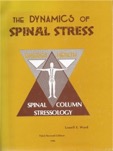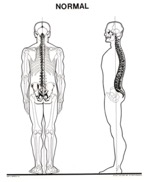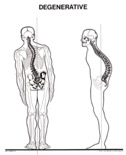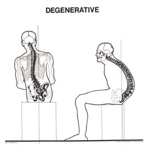Spinal stress: an accidental discovery
The spinal stress story started in an unlikely place, in Middletown, Pennsylvania. After graduation, I worked for Monroe Schneier, DC in Middletown for a total of one week. I liked Dr. Schneier but didn’t like Middletown. Shortly after I left it was the site of a partial nuclear reactor meltdown in nearby Three Mile Island. That is still considered the worst nuclear power plant accident in the US. Don’t be alarmed, it wasn’t my fault!
Back to Dr. Schneier. He was a political animal. Dr. Schneier would often go “to the hill,” the state Capitol building in nearby Harrisburg, where he cared for many of the state legislators, lobbyists and employees.
He used his connections to lobby for the Chiropractic Fellowship of Pennsylvania, fighting for healthcare freedom. He singlehandedly got Pennsylvania’s vaccine laws to include a philosophical as well as a religious exemption. Dr. Schneier was my hero.
SIDS and ARCS research
Dr. Schneier founded ARCS, the Academy for Research in the Chiropractic Sciences. ARCS sponsored studies on the relationship between spinal stress at birth and crib death (Sudden Infant Death Syndrome or SIDS).
Working with a county coroner, he arranged for newly-deceased to be X-rayed in a special infant holder designed for spinal analysis. Severe upper neck (atlas or C1) subluxations (or misalignments) were found in that area in many of the babies that were SIDS victims. The findings were presented at an ARCS conference and reported in the St. Louis Post-Dispatch. This information was then picked up by many of the national wire services—possibly a first for chiropractic research.
At that conference, I met some of the profession’s greats: Dr. I.N. Toftness, developer of the analysis and adjusting system that bears his name and Dr. Henri Gillet, developer of motion palpation. Last but not least, I met Dr. Lowell Ward, developer of Spinal Column Stressology and author of The Dynamics of Spinal Stress.
Lowell Ward, DC
Dr. Ward described a patient who felt pain-free while seated but suffered from intense sciatic pain when standing.

Lowell Ward, D.C.
He X-rayed her when she was standing and saw a relatively balanced, healthy, non-subluxated spine. Then he decided to see what her spine looked like while she was in her painful posture—sitting.
 To his surprise, her sitting films revealed an unbalanced, distorted and subluxated or misaligned spine with pathologies not seen in her standing film. That wasn’t supposed to happen. Spines aren’t “supposed” to change so quickly.
To his surprise, her sitting films revealed an unbalanced, distorted and subluxated or misaligned spine with pathologies not seen in her standing film. That wasn’t supposed to happen. Spines aren’t “supposed” to change so quickly.
“How many other subluxations, distortions and pathologies have I been missing by limiting my analysis to one posture?” he wondered.
He decided to find out. So he began to take patients’ X-rays (radiographs as Dr. Ward referred to them) as they were standing AND sitting. When he analyzed thousands of patients he discovered that significant changes in different postures were common! He’d see subluxations, pathologies, spinal distortions and imbalances in one posture that were not seen in another posture. This was a new discovery!
Spinal stress: car accidents, sports and postural damage—arthritis and discs
 Dr. Ward’s findings could reveal past trauma. For example, he could tell how a person was thrown around in a car accident by comparing their seated and standing spinal postures.
Dr. Ward’s findings could reveal past trauma. For example, he could tell how a person was thrown around in a car accident by comparing their seated and standing spinal postures.
Dr. Ward documented other extreme differences. For example, a person’s neck (cervical) curve could be straight (military neck) or even reversed (kyphotic) while seated. Yet the patient could have a normal (lordotic) curve when standing. Or the reverse could occur. Many pathologies would remain if a doctor only took X-ray films of the patient in one posture!
 Conversely, a person injured while playing sports or falling was often shown to reveal more damage in the standing posture and little or no damage in the seated posture.
Conversely, a person injured while playing sports or falling was often shown to reveal more damage in the standing posture and little or no damage in the seated posture.
The differences were sometimes dramatic and unexpected. For example, disk bulging would be seen to come and go from one posture to another. Even bone degeneration (eburnation) and even bone growths (lipping and spurring) would come and go.
Once I asked an MRI company representative if he ever saw significant changes in the spine when the patient was imaged in different postures. “We see it all the time,” he said. “We’ve even seen arthritis come and go as people go from standing to sitting.”
This was a revelation: spinal stress, even spinal pathology, could be dependent on a person’s posture.
Measuring spinal stress
Dr. Hans Selye, author of The Stress of Life inspired Dr. Ward to measure how stress affects the spine.

Working with an aerospace engineer Dr. Ward developed methods of quantifying the patient’s structural stress relative to gravity. He recorded the stress levels of a relatively normal and deteriorating spine. After that, he monitored a patient’s progress using follow-up X-rays.
Dr. Ward’s postural analysis consisted of four 14”x 36” (full spine) X-ray films of the patient: two of the patient standing and seated facing the X-ray and two of the patient standing and seated facing laterally.
 The center of the patient’s pelvis was determined and measured relative to various spinal areas and to the center of their skull. An off-centered spine was under much more stress causing the patient to expend much more energy leading ultimately to exhaustion.
The center of the patient’s pelvis was determined and measured relative to various spinal areas and to the center of their skull. An off-centered spine was under much more stress causing the patient to expend much more energy leading ultimately to exhaustion.
 Dr. Ward measured spinal curves and distances from the center of gravity. He also measured the length of the spine searching for meningeal tension. No one had ever analyzed the spine in such a manner before.
Dr. Ward measured spinal curves and distances from the center of gravity. He also measured the length of the spine searching for meningeal tension. No one had ever analyzed the spine in such a manner before.
Spinal stress: accident dynamics and retracing
It was discovered that films could reveal the dynamics of an accident. For example, an accident victim who was thrown forward and to the left would reveal a spine with the head off-center forward and left (in the seated posture).
After corrections/adjustments, the posture would get even worse, yet the patient usually reported relief from symptoms. “The adjustment unlocks the fixated/subluxated spine permitting the patient to do their own dance of healing as they release spinal stress,” Dr. Ward taught. This appeared to be the X-ray equivalent of retracing—the recapitulation of old symptoms as a person heals. Eventually, the body would return to a more normal position as it continued its “dance of healing.”
Meningeal stress
Dr. BJ Palmer, considered the developer of chiropractic, discussed the “torqued meningeal subluxation” in his classic book, The Subluxation Specific. The meninges play a role in body structure. Dr. Ward’s work expanded upon the role the meninges play.
Dr. Ward described the body structure from the skull to the tailbone as a “single synchronous functional unit” with the meninges connecting it all together. He looked at the whole person’s structure and stress.
 Inspired by the work of the Swedish neurosurgeon Alf Breig, MD in Adverse Mechanical Stress in the Central Nervous System he investigated how the meninges affected structure as well as nervous system health and disease. Meninges are wrappings around the brain and spinal cord that connect all the body parts together.
Inspired by the work of the Swedish neurosurgeon Alf Breig, MD in Adverse Mechanical Stress in the Central Nervous System he investigated how the meninges affected structure as well as nervous system health and disease. Meninges are wrappings around the brain and spinal cord that connect all the body parts together.
Spinal Column Stressology
Dr. Ward developed a technique he called Spinal Column Stressology. Spinal Column Stressology’s goal was to release spinal, meningeal or neurological stress from the nervous system using chiropractic-inspired corrections (adjustments). In contrast, Dr. Breig, being a surgeon, had a different approach to releasing meningeal stress: surgery. He would cut the meninges, particularly the filum terminale—a drastic procedure that could free a person from pain but cause other problems. Dr. Ward’s non-surgical approach was far safer, gentler and more effective.
Toe walking, head banging and thumb sucking
Intense meningeal tension could affect the entire body, structure, posture, muscles, ligaments, tendons, joints, brain, spinal cord and cranial nerves. Children experiencing meningeal tension or stress would relieve the pressure by thumb sucking, toe walking or in more extreme cases of tension, head banging.
The cause of this adverse meningeal tension is birth trauma and toxicity. A main cause of meningeal toxicity is a sub-clinical meningitis caused by vaccinations. (1)
One of the most intriguing of Dr. Ward’s clinical findings was what he termed “emotional profiling.” He developed a system of revealing personality traits and emotional trauma from analyzing posture from X-ray analysis. How did he do this? I’ll address this in my next post.
References
- Coulter HL. Vaccination, Social Violence and Criminality: The Medical Assault on the American Brain. Washington, DC: Center for Empirical Medicine. 1990.
Dr. Tedd Koren is the discoverer of Koren Specific Technique and the author of both Cancer is Natural, So is the Cure and Childhood Vaccination: Questions All Parents Should Ask. His chiropractic patient education materials can be found at korenpublications.com.
Please scroll down below to leave me a comment.
And please share this far and wide – patients, colleagues, friends & family!
The buttons are on the right.=====>

Dr. Tedd Koren
Dr. Koren, originally from Brooklyn, NY, lives in Montgomery County, PA. A graduate of the U of Miami and Sherman College of Chiropractic, he writes, lectures and teaches in the US, Europe and Australia as well as takes care of patients and fights for healthcare freedom. Dr. Koren and his wife Beth have two children.











Great post. This was a riveting read! I still have a hard time imagining how arthritis can come and go with a change from sitting to standing. Or vice versa. The human body is amazing!
Yes, I found it pretty amazing myself. It’s a shame Dr. Ward’s findings have been largely ignored.
Thanks Tedd, another great article to take the lid off our limited thinking. Just what I needed. I checked and adjusted myself after reading this article and the one on addictions etc.
Thanks for the feedback Simon. Don’t forget, you need care too. Is anyone doing KST near you?
I love the idea of the body going into its healing cycle. That seems to happen all the time with the energy approach that we use. Patients returning for their follow up appointment often comment that they felt things happening in their body for some days after the treatment. In one case the patient felt his back click six days after treatment and the symptoms all disappeared from that point.
Retracing is fascinating and needs to be studied more. I like to tell patients that they may have weird dreams after a visit, especially the first visit. I think it’s that emotional stress they have been consciously avoiding is coming out. Do you ever see that?